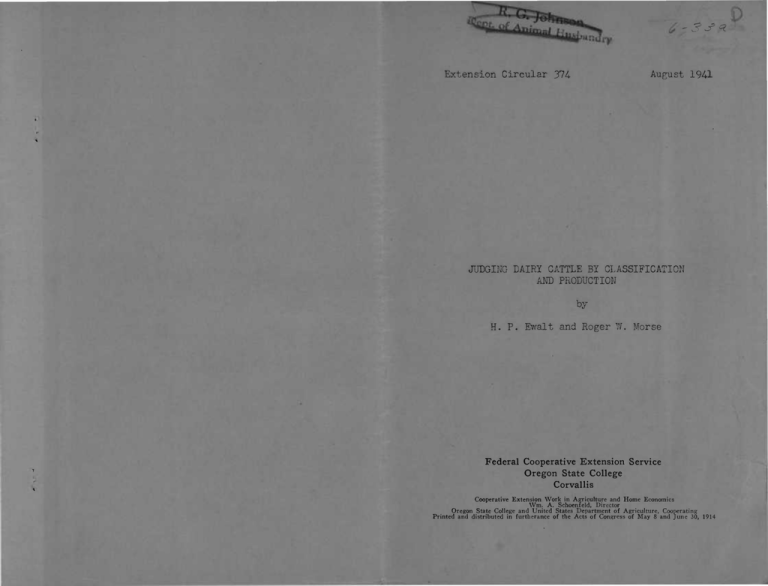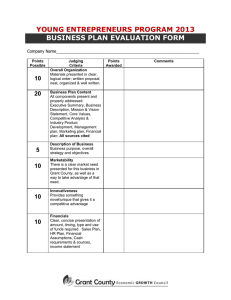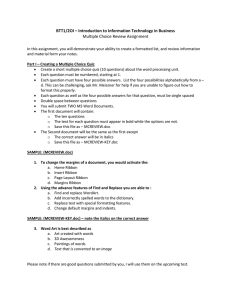-SS*
advertisement

-SS* Extension Circular 374- August 19^1 JUDGING DAIRY CATTLE BY CLASSIFICATION AND PRODUCTION by H. P. Ewalt and Roger W. Morse Federal Cooperative Extension Service Oregon State College Corvallis Cooperative Extension Work in Agriculture and Home Economics Wm. A. Schoenfeld, Director Oregon State College and United States Department of Agriculture, CooperatinR Printed and distributed in furtherance of the Acts of Congress of May 8 and June 30, 1914 Extension Circular 374 August 19A1 JUDGING MIRY CATTLE BY CLASSIFICATION AND PRODUCTION by H. P. Ewalt and Roger W. Morse The classification system of dairy cattle judging recognizes the fact that for all practical purposes the cow that stands third or fourth in our present shows may be just as good as the cow standing in first place. Under the classification system of judging, animals that score within 5 points of one another will all be placed in the same class, receive the same color ribbons and the same awards. To this classification system of judging may also be added a recognition of production records which if properly worked out will place proper emphasis on both type and producing ability. Two methods of recognizing production records may be used. The first, simplest, and probably most practical is that of requiring minimum production records in all classes 3 years old or over. The second method is using the actual production records coordinated together with the classification of the animal in determining the final placings. When this method of judging, in which both type and production are used, the blue-ribbon cow is penalized if she has low production and the red-ribbon or yellow-ribbon cow is credited on type and advanced in classification if she has high production. It would seem that this is a much fairer and more educational method of making awards. In 4-H or Future farmers of America shows where the classes may be large in number, there may be several animals that for all practical purposes should be considered equal. Under this system of judging, these animals are given the same award. The method suggested for division of cash awards divides the premium money among all exhibitors according to the placing of their animals. This again is more encouraging than dividing premiums among exhibitors of top animals only. When this system of judging is used, it should be fully explained to both exhibitors and visitors in order that they may thoroughly understand and get the full benefit of the placings made. Quite a number of variations may be employed in planning a show and the following methods are suggested as guides for those who wish to use this system of making awards in their dairy shows. Classification Show With or Without Production Requirements The following system is suggested for classification judging both with and without the consideration of production records: 1. Entries: A. Breeds to be specified by show committee. B. All animals of producing age may be required to have dairy herd improvement association or official records. G. In production shows all entries and records must be made 2 weeks previous to date of show. D. All production records must be converted to mature basis, 305-day, twice-s-day milking. If cow has more than one record the highest record may be used. 2. Health: All animals must be free from tuberculosisj all animals must show negative test for Bang's disease 30 days prior to date of show or come from accredited herd that has shown no reactors for the previous 12 months. 3. Classes for each breed: females; (1) (2) (3) (4) (5) 4 years and over 3 years and under /+ years 2 years and under 3 years including senior yearlings in milk 1 year and under 2 years 6 months to 1 year Males: (1) (2) (3) 3 years and over 2 years and under 3 years 1 year and under 2 years Groups: (1) (2) (3) 4. Production of Dam Get of Sire Dairy Herd 2 animals, either sex any age 3 animals, only 1 male 4- animals, all females Classification placings for each age group, every animal to be placed in one of the 5 classes according to type. (1) (2) (3) (4) (5) Class Class Class Class Class A B C D E - Purple ribbon Blue ribbon Red ribbon White ribbon Yellow ribbon Class A is an exceptional class and animals in this class must score 90 points or above. No champion animals to be selected. In the case of shows that desire to recognize varying production records, the following system has been successfully used over a period of years in some of the eastern states. Classes are first placed according to paragraph U above and then regrouped on the following system. Example: A Class B, or blue-ribbon animal, that had a mature equivalent, 305-day production record of 500 pounds of butterfat or over would be advanced to Class A and given a purple ribbon. If, however, her production were only 400 to 449 pounds of butterfat, inclusive, she should be reduced to Class C and given a red ribbon. Basis of awards in each age group: Class A - 450 lbs. fat and over - Purple Class A - 400-4^9 - Blue Class A - 350-399 - Red Class Class Class Class B B B B - 500 lbs. fat and over - Purple - Blue 450-499 - Red 400-449 White 350-399 Class Class Class Class C C C C - 500 lbs. fat and over - Blue - Red 450-499 - White 400-449 - Yellow 350-399 Class Class Class Class D D D D - 550 lbs. fat and over - Blue - Red 500-549 - White 450-499 - Yellow 400-4.49 Class E - 400 lbs. fat and over - Yellow Class E - 400 or less - no ribbon 6. Distribution of premium money: Purple ribbon Blue ribbon Red ribbon White ribbon Yellow ribbon 5 4 3 2 1 points points points points point Multiply the point value by the number of animals receiving that color ribbon. Example: 2 blue-ribbon animals by 4| 5 red-ribbon animals by 3, etc. Add the total number of points and divide into the amount of premium money for the class. This gives the money per point, then multiply the value per point by the number of points an animel has ano this gives the amount of premium money for each animal. The production requirements may be raised or lowered to meet local conditions. Summary The classification system of judging dairy cattle has much merit, particularly in A-H Club, Future Farmers of America, special breed shows, and county fairs. When properly used, it has a number of educational advantages over the standard system of judging. To the classification system of judging may be added requirements that all animals of 3 years old and over have such minimum production records as are set by the show committee. The more complicated system outlined herein has been successfully used and if it is desired to give recognition to the actual production records of different animals, the system is practical if carefully planned. oOo




